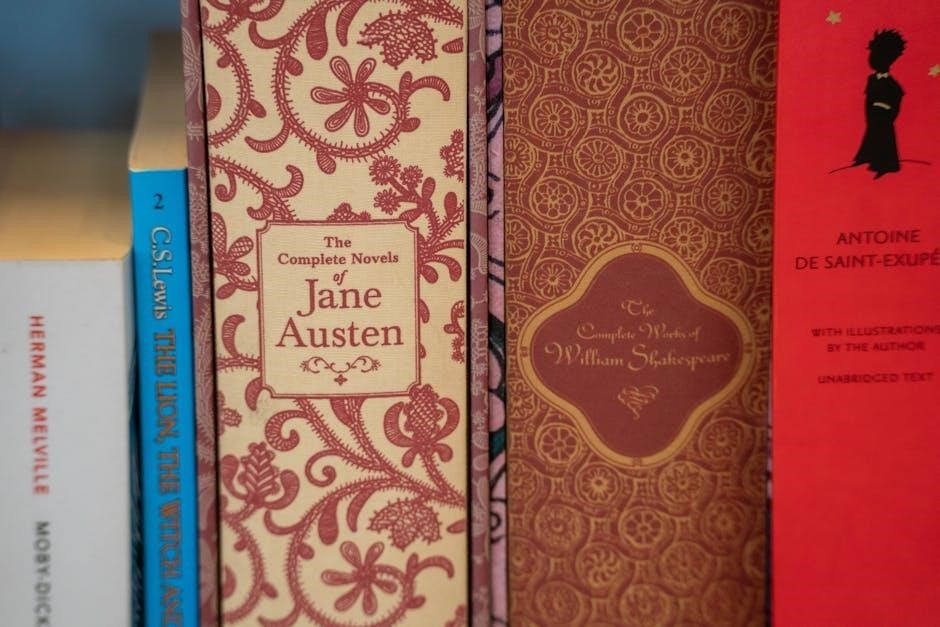Jane Austen’s Emma is a timeless novel exploring themes of social class, matchmaking, and self-discovery․ It centers on Emma Woodhouse, a wealthy, well-meaning yet flawed protagonist whose attempts to interfere in others’ lives often lead to comedic misunderstandings․ Through her journey, Austen masterfully portrays personal growth and societal norms, offering insights into the human condition that remain relevant today․
Background of the Novel
Jane Austen’s Emma was first published in 1816, during a period of significant social change in England․ The novel is set in the fictional village of Highbury, which reflects Austen’s familiarity with rural life and her keen observation of societal hierarchies․ Austen began writing Emma in 1814, drawing inspiration from her own experiences and the cultural norms of her time․ The novel was initially titled Emma Woodhouse and was intended to explore themes of matchmaking, class distinctions, and personal growth․ Austen’s use of free-indirect discourse in Emma marked a literary innovation, allowing readers to deeply connect with the protagonist’s thoughts and emotions․ The novel was well-received upon its release, with many praising its wit and insightful portrayal of society․
Protagonist Emma Woodhouse: Characteristics and Role
Emma Woodhouse is the central character of the novel, a wealthy, intelligent, and strong-willed young woman who often overestimates her ability to manipulate others’ lives․ Living with her father at Hartfield, Emma fancies herself a skilled matchmaker but frequently misjudges situations, leading to humorous and awkward consequences․ Her interfering nature stems from a desire to help others, yet it reveals her own naivety and social biases․ Throughout the novel, Emma’s character evolves as she confronts her flaws, particularly through her relationship with Mr․ Knightley, who challenges her perceptions․ Her journey from self-delusion to self-awareness makes her one of Austen’s most complex and enduring protagonists, driving the novel’s exploration of personal growth and societal norms․
Plot Summary of Emma
Jane Austen’s Emma follows the story of Emma Woodhouse, a young woman who meddles in the lives of those around her, often causing misunderstandings․ Her attempts to play matchmaker for her friend Harriet Smith lead to complications, particularly when her efforts are misinterpreted by Mr․ Elton․ Meanwhile, Emma’s own feelings for Mr․ Knightley evolve as she learns to recognize her flaws and the true nature of her relationships․ The novel concludes with Emma’s realization of her mistakes and the eventual union of the main characters, highlighting themes of love, social class, and personal growth․
Setting: Highbury and Its Significance
The novel is set in the fictional town of Highbury, which serves as a microcosm of English rural society in the early 19th century․ Highbury, modeled after real-life towns like Cobham, represents a close-knit community where social interactions and class distinctions are starkly visible․ The setting plays a crucial role in shaping the characters’ lives and relationships, as the limited social circle amplifies misunderstandings and romantic entanglements․ Locations such as Hartfield, Emma’s home, and Randalls symbolize the characters’ social status and roles within the community․ The confined setting allows Austen to explore themes of social hierarchy, gossip, and personal growth, making Highbury an integral part of the narrative’s dynamic․
Key Events and Romantic Misadventures
Emma’s well-meaning but misguided attempts at matchmaking drive the novel’s central conflicts․ She persuades Harriet Smith to reject a marriage proposal from Robert Martin, believing him unsuitable, and encourages her to pursue the clergyman Mr․ Elton instead; However, Mr․ Elton’s true intentions are revealed when he proposes to Emma herself, leading to embarrassment and dismay․ Meanwhile, the arrival of Jane Fairfax and Frank Churchill introduces further complications, as their secret engagement creates tension․ Emma’s misadventures culminate in a series of misunderstandings and revelations, ultimately leading to her realization of her own feelings for Mr․ Knightley․ These events highlight Austen’s mastery of comedic misadventures and romantic entanglements․

Major Characters in Emma
The novel focuses on Emma Woodhouse, a wealthy, well-meaning protagonist, and her mentor Mr․ Knightley․ Other key characters include Harriet Smith, Mr․ Elton, and Jane Fairfax․

Emma Woodhouse: Her Personality and Development
Emma Woodhouse is a complex and dynamic protagonist, portrayed as intelligent, wealthy, and strong-willed but also meddling and self-deluded; Initially, her confidence in her matchmaking abilities leads to interference in others’ lives, often causing misunderstandings․ Her interactions with characters like Harriet Smith and Mr․ Elton reveal her flaws, such as her tendency to judge others based on social status․ However, through her mistakes and Mr․ Knightley’s guidance, Emma undergoes significant personal growth․ She learns to recognize her own biases and errors, developing greater empathy and self-awareness․ By the novel’s end, Emma evolves from a naive, manipulative figure to a more mature and humble individual, ready to embrace her own happiness and responsibilities․
Mr․ Knightley: His Influence and Relationship with Emma
Mr․ Knightley, a close family friend and Emma’s eventual love interest, serves as a moral guide and voice of reason in her life․ His wisdom and insight into Emma’s flaws, particularly her meddling and social prejudices, make him a crucial figure in her development․ Knightley’s disapproval of Emma’s matchmaking attempts, especially with Harriet Smith, highlights his concern for her well-being and societal harmony․ Despite his occasional sternness, his genuine care for Emma fosters trust and respect between them․ Their relationship evolves from a paternal dynamic to a romantic partnership, with Knightley’s influence aiding Emma’s growth toward self-awareness and humility․ His steady character balances Emma’s impulsiveness, making him indispensable to her personal journey․

Themes in Emma
Jane Austen’s Emma explores themes of love, social class, and self-discovery, highlighting the dangers of misjudgment and the complexities of relationships in a rigid society․
Social Class and Status in the Novel
In Emma, Jane Austen intricately portrays the rigid social hierarchy of 19th-century England, with characters defined by their wealth and status․ Emma Woodhouse, as a member of the upper class, embodies the privileges and responsibilities associated with her position․ Her attempts at matchmaking often highlight the limitations and expectations imposed by societal norms․ The novel critiques the class system through characters like Harriet Smith, who lacks connections but possesses moral worth, and Mr․ Elton, whose ambition reflects the social climbing prevalent at the time․ Austen’s depiction of Highbury society underscores the interplay between class, morality, and personal identity, offering a nuanced commentary on the era’s social structures․
Personal Growth and Self-Realization
Emma Woodhouse undergoes significant personal growth throughout the novel, evolving from a self-assured yet misguided matchmaker to a humbler, self-aware individual․ Her initial confidence in her abilities often leads to misunderstandings and harm to others, particularly Harriet Smith․ However, through Mr․ Knightley’s gentle yet firm critiques, Emma begins to recognize her flaws and the consequences of her actions․ This realization sparks a journey of self-reflection, where she learns to balance her assertiveness with empathy and humility․ By the novel’s end, Emma’s newfound understanding of herself and others allows her to embrace a more mature and compassionate perspective, ultimately leading to her own happiness and fulfillment․
Literary Significance of Emma
Jane Austen’s Emma is celebrated for its innovative use of free-indirect discourse, offering profound insights into human nature and societal norms, ensuring its enduring literary acclaim․
Jane Austen’s Use of Free-Indirect Discourse
Jane Austen’s innovative use of free-indirect discourse in Emma revolutionized literary narrative techniques․ This storytelling method allows readers to experience Emma’s thoughts and feelings directly, blending third-person narration with a character’s internal perspective․ Austen masterfully employs this technique to provide intimate insights into Emma’s psyche, highlighting her flaws, growth, and ultimate self-awareness․ By merging the narrator’s voice with Emma’s consciousness, Austen creates a deeper connection between the reader and the protagonist․ This literary device not only enhances character development but also critiques societal norms subtly․ Free-indirect discourse in Emma remains a landmark in literary history, demonstrating Austen’s pioneering approach to psychological storytelling and her enduring influence on narrative fiction․
Critical Reception and Legacy
Jane Austen’s Emma initially received mixed reviews, with some critics finding its focus on everyday life and lack of dramatic action unappealing․ However, over time, the novel has come to be celebrated as one of Austen’s masterpieces․ Modern critics praising its nuanced exploration of human nature and its sharp social commentary․ The novel’s innovative use of free-indirect discourse has been particularly lauded for its ability to immerse readers in Emma’s thoughts and emotions․ Emma has also had a lasting impact on literature, influencing countless adaptations, films, and reinterpretations․ Its enduring popularity underscores its relevance as a timeless commentary on societal norms and personal growth, solidifying its place as a cornerstone of English literature․
Jane Austen’s Emma remains a cherished novel, offering timeless insights into societal norms, human nature, and personal growth․ Its enduring appeal lies in its relatable themes and nuanced characters, ensuring its continued relevance in modern literature․
Emma’s Lasting Impact on Literature
Jane Austen’s Emma has left an indelible mark on literature, celebrated for its nuanced portrayal of social dynamics and human nature․ The novel’s exploration of themes such as social class, personal growth, and the complexities of relationships continues to resonate with readers and scholars alike․ Austen’s innovative use of free-indirect discourse in Emma revolutionized narrative techniques, influencing countless authors and literary works․ Its timeless appeal is evident in its enduring popularity and numerous adaptations across various media․ Emma remains a cornerstone of English literature, offering insights into societal norms and individual development that are as relevant today as they were upon its publication․ Its influence underscores Austen’s enduring legacy as a literary giant․
Final Thoughts on the Novel’s Relevance
Jane Austen’s Emma remains a profoundly relevant work, offering timeless insights into human nature, societal dynamics, and personal evolution․ Its exploration of themes such as social class, self-awareness, and the complexities of relationships continues to resonate with modern audiences․ The novel’s nuanced characters and witty dialogue provide a lens through which readers can reflect on their own behaviors and aspirations․ Austen’s mastery of free-indirect discourse allows for a deep connection with Emma’s journey, making her growth and self-realization universally relatable․ As a result, Emma not only endures as a literary classic but also continues to inspire new adaptations and interpretations, ensuring its place in the cultural consciousness for generations to come․
